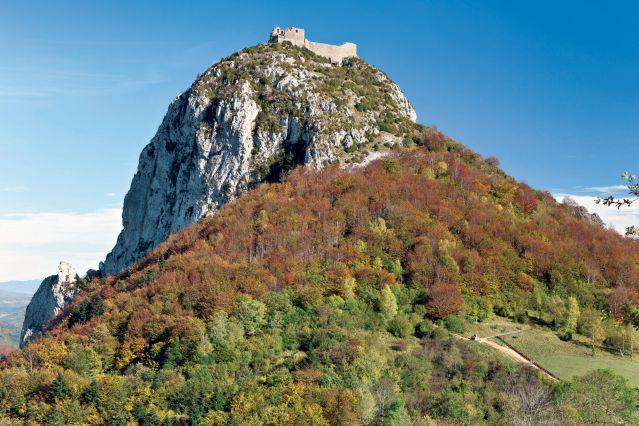Places to Visit
Breaking away from the norm here at the page, as most of my other plans are being stymied from a variety of situations, I’d like to explore with any potential readers the first of many places I’ve never been, but would in a heartbeat. One of the most intriguing to me is in Southwestern France, in the mountains of the Languedoc region. It’s called Montségur Castle.
Montségur holds many a tale in history, mystery and possibly even conspiracy. It’s drawn writers, poets, thinkers, romanticists and archaeologists and all for different yet similar reasons. Most people these days are probably attracted to the stories of the Knights Templar or if they’re more informed, the Cathars.

Montségur Castle as it might have appeared in the 14th Century
Montségur was one of the strongholds of the Cathars, a religious offshoot of Christianity whose beliefs were eventually viewed as heretical by the Catholic Church. The height of their influence was during the 12th and 14th centuries before becoming too large for the Catholic Pope to ignore. The Catholics, after a lengthy period of undermining the credibility of rulers following or allied with the Cathars, chose to completely wipe them out with military might, an event called the Albigensean Crusade. Montségur was the final stand for the Cathar faith, an impenetrable fortress at the extreme top of a mountain that kept the besieging army in check. Those willing to renounce their faith and rejoin the Catholic religion were allowed to leave the fortress. Those that were unwilling to do so surrendered after nine months, marched down to the crusading army and were all burned at the stake. Over two hundred men and women were burned as heretics, with the fortress of Montségur destroyed afterwards.

The Montségur area as it appears today
The Cathars weren’t completely gone at this point, but they held no lands or major power after Montségur fell to the Catholic Church’s crusade against them. Gradually, they faded from sight, but like all great stories, myths and legends remained. Historians and archaeologists believe the Cathars were forward-thinking, allowing for women to be taught equally as men, as well as letting them be part of the Cathar Church’s organization. The Cathars traded with Jews and Muslims and let them live in their region of France without persecution. The specifics of the religion are somewhat shrouded in mystery as the Catholics destroyed every text or scroll holding the tenants of the Cathars. It’s widely believed that they were a dualist faith, worshipping both good and evil equally, with the intention of learning how to live without sin and return to the righteous and godly that cannot be found on Earth. Many researchers have tried to unravel the religion and come up with little to support it beyond what is theorized. Regardless, the Cathars, by the latter half of the 1300’s, were a dead religion.
Myths surround Montségur Castle and the lands nearby. It’s been claimed that many of the faith escaped the siege at Montségur through underground passages and caves, or even over the side of the mountain unseen by the besieging army. It’s been said that the Cathars were in cahoots with the Knights Templar and that they may have held the Holy Grail at Montségur at the time of the Albigensean Crusade. Some researchers think the Cathars held secrets that neither the Templars nor the Catholics were aware of, some of which go to the earliest years of the Christian beliefs.

Montségur Castle and the imposing precipice
Many interesting theories have come from extremely strange sources. I think the most odd is that of German researcher Otto Rahn, who wrote two books connecting the Cathars to the story of Parzifal, a German-written tale of the Knight Percival’s search for the Holy Grail. Rahn made claim that Parzifal was a thinly-veiled chronicle of the Cathars. Rahn made his trek to the Languedoc in the early 1930’s, before he joined a certain Adolf Hitler’s Allgemeine-SS. Rahn died in 1939 under mysterious circumstances after resigning from the SS. Questions remain about Rahn and his research and whether or not he was doing it for Hitler, who had a rather strange attachment to occult items or locales.

Montségur Castle now – ruins of a 1700’s fortification
Whether or not the site has some mysterious draw for people, Montségur Castle continues to intrigue me not only in the continued sense of strange and historically significant, but for the general beauty which was likely one of the reasons the Cathars chose the location in the first place.
Read more about the Albigensean Crusade and the Cathars.
Read more on the curious Otto Rahn.



©2018 Pint O’ Comics | About Us | Contact Us | Site created by One Flight Up Design